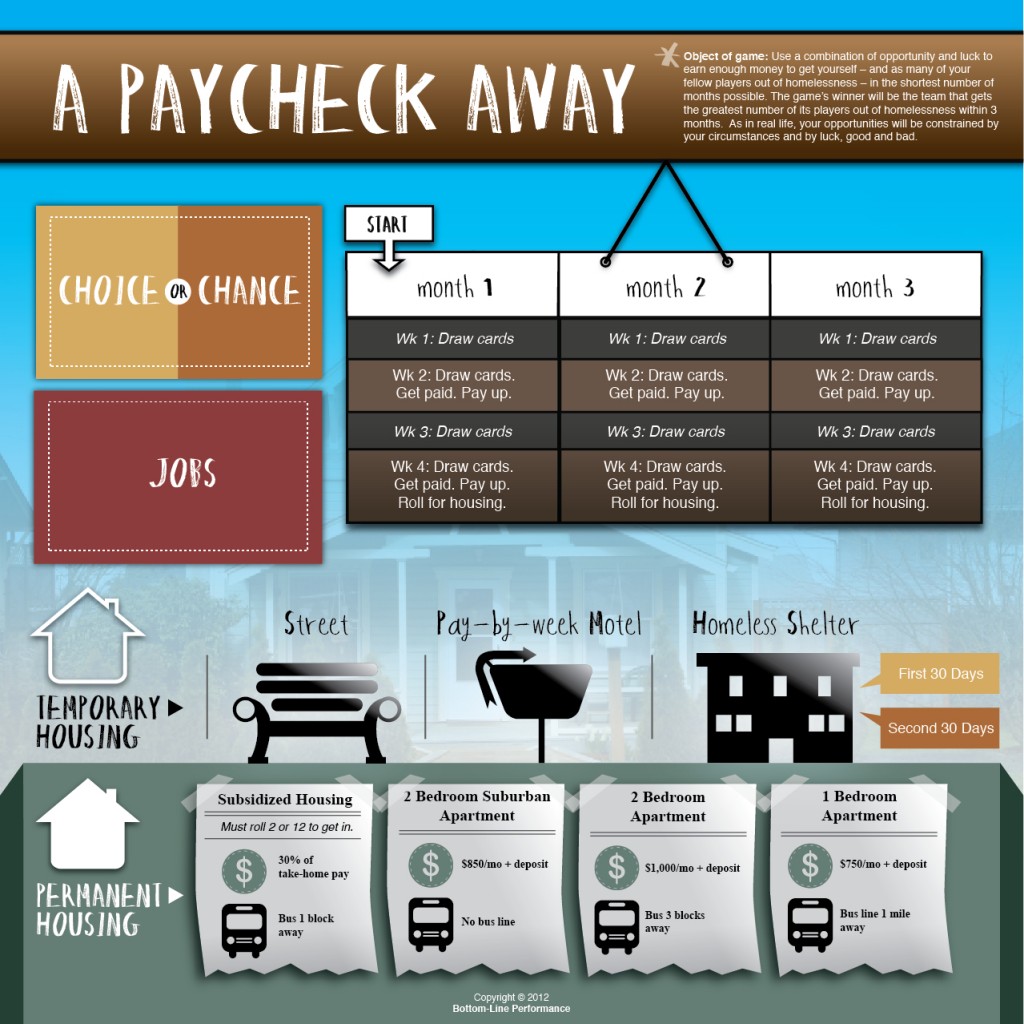For those of you who have been following our occasional case study on learning game design, the end is near. The finish line of game development on our game A Paycheck Away is so close I can symbolically touch it. By month’s end, we will call development done and move into production of the game.
As a refresher – here’s the initial game board design followed by the current design. We’ve come a long way since the first prototype!
Our external play test went very, very well. We got the highest compliment you can bestow on a game. Testers rated it 4+ out of 5 for “flow,” which was a humbling experience to have happen. For our third playtest…this was a wow. With the feedback from testers, I feel optimistic about our odds of increasing the rating to 5.
We had 17 testers and the overall “engagement” rating was 4+ on a 5-point scale. Here’s a few of the testers’ comments. While they gave us some ideas for what to change, here’s a smattering of the “wow” comments we heard:
- It was completely engaging.
- Homelessness – the real world. It was like being immersed in it, some of the same emotions in a safe way?
- It will change the way you think.
- It was pretty eye-opening. You can easily judge someone without knowing the situation. Lots of one step forward and two steps back without you having control over it.
So how did we get to “wow?” Games all have the common structural elements I’ve listed below. As we went through various iterations, we adjusted these elements based on testers’ feedback. I’m sharing some of what we adjusted so you can see how things changed as we went along. You can use these structural elements as a guide when designing your own games, taking notes on what to change as you play test:
- Players – how many? Single player or multi-player? In A Paycheck Away we started with a 5-player game. Through testing, we adjusted to make one role a “game master” and allowed people to play individually or in teams of two for the other roles.
- Objectives – what’s the point of the game? What are players trying to do? In A Paycheck Away, the game objective is to get yourself – and as many fellow players as possible – out of homelessness within 3 months.
- Procedures – How do you play? We had to specify what happens on a turn, how play proceeds, how the game ends. We adjusted procedures significantly through our testing, abandoning a week-by-week approach to a bi-monthly approach in the interest of time.
- Rules – What’s allowed? What’s not? What consequences occur in response to specific actions? An example of a rule in our game is: If you have children under age 10 and you accept a job, you must pay $120/week per child for childcare. Some rules got abandoned and others got added as we tested with the focus being on reducing play complexity and maximizing “fun” of the experience.
- Resources – what resources will players have and how will these be limited? In A Paycheck Away the resources – all of which are limited – include money, time, health, and jobs. Through play testing, we came up with the best combination of resources and limits.
- Conflict – The game is no fun if there is no conflict built in…but we found that cooperation worked far better than competition in this game. We created conflict in other ways: by limiting resources or requiring players to decide between two tough choices.
- Boundaries – players want to be immersed in the game, but they also need to recognize the boundaries of the game. We felt we struck a great balance. Players knew the game wasn’t real…but most reported strongly identifying with the character they played.
- Outcome – this one is critical. For players to stay engaged, they must feel they have a realistic chance of hitting the game objective…but the outcome needs to be uncertain. Our testing revealed we did a great job with this one. It was a significant reason players reported a sense of flow while playing. They were fully engaged in the experience and vested in the outcome.
Next step? Take the show on the road and have a group of IUPUI students play the finished game and participate in a debrief session. We know the game works; now we need to figure out the optimal way to debrief the experience for participants. This debrief distinguishes our game from a game you might purchase in a game store. Players talk about their experience and what they learned from it…something that recreational games don’t deliberately set out to do.





